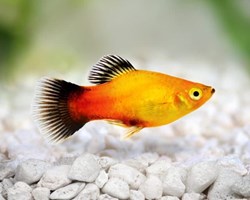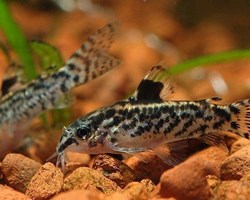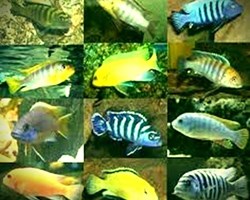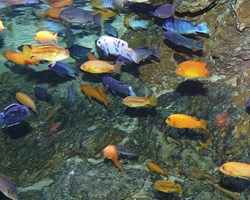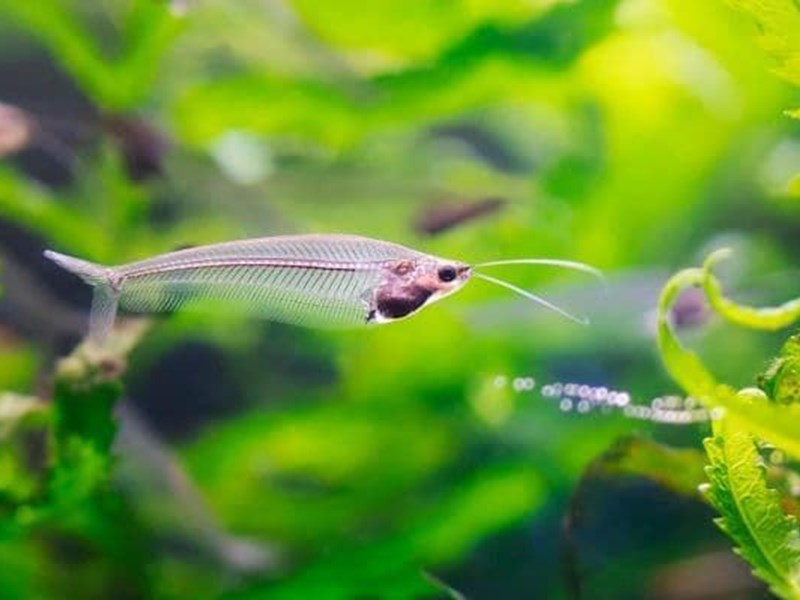
INDEX:
1.- ORIGIN.
2.- GENERAL CHARACTERISTICS.
3.- BEHAVIOR.
4.- TYPE OF AQUARIUM.
5.- FOOD.
6.- CARE.
7.- DISEASES.
1.- ORIGIN:
The glass catfish, family Siluridae, is undoubtedly one of the most amazing freshwater community aquarium fish. Its body is completely transparent, without coloration on the scales, allowing the bones and thorns to be seen.
It only has a silver coloration on the head.
It has no dorsal fin that is reduced to just a radius.
The anal fin is very elongated, extending from the pectoral fins to the tail.
Its caudal fin is symmetrical. It has two barbels that serve to locate food.
The arched shape of its body allows it to swim obliquely with its tail down.
It does not present sexual dimorphism and can reach sizes of up to 15 cm, in the aquarium it will not exceed 10 cm.
Krytopterus bicirrhis (Cuvier and Valenciennes, 1839) is found in Java, Sumatra, Borneo and to a lesser extent in East India and Thailand.
It inhabits fast currents that are mostly turbid with many particles in suspension with low visibility.
This poor visibility has developed in the glass catfish a greater sensitivity in its lateral line as well as the two commented barbels.
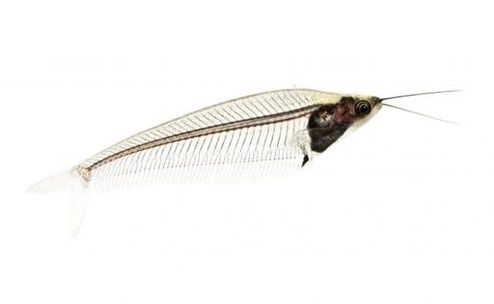
2.- GENERAL CHARACTERISTICS:
Mascot : Fish
Family: Siluridae (Catfish)
Group: Catfish
Origin: Asia
Size: 10-15cm.
The Crystal Catfish, also called Bicirri, Glass Fish, Feather Fish, Crystal Catfish and Java Crystal, is a tropical fish that belongs to the silurid family and is of Asian origin (Cambodia, Vietnam, Java, Borneo).
Like all catfish, the glass catfish has a slender body, progressively thinning from head to tail.
In nature it reaches 15 cm. in length, but in captivity it does not exceed 10 cm.
It is elongated and somewhat flattened on the sides, and has a small head just like its eyes.
Its mouth, sometimes quite large, contains a long barbel on each side of the upper lip that can extend forward.
The anal fin is quite long and the tail is divided in two, the lower part being slightly longer.
However, the most remarkable characteristic of this fish is, without a doubt, its transparency, which in the natural environment it uses as protection against predators, camouflaging itself among the vegetation.
Thanks to this particularity, the skeleton can be clearly seen as well as some of its internal organs.
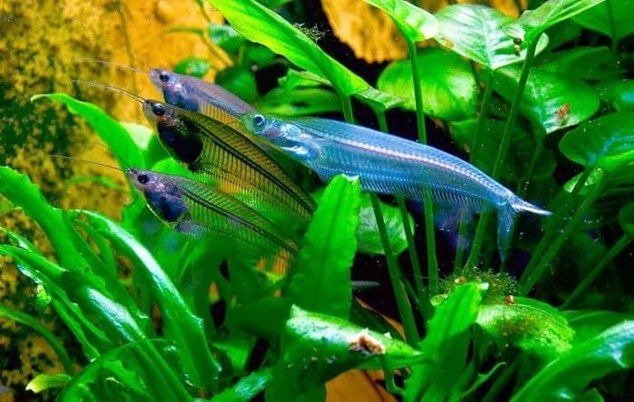
3.- BEHAVIOUR:
It is a very peaceful and gregarious fish.
It hates loneliness and lives in small groups of individuals of its own kind.
It is very calm and often static, since it can remain for a long time in the same area almost without moving.
When sleeping, it stands diagonally next to a branch or plant, with its head up, so that its spine blends in with the surroundings.
Swim slowly in intermediate zones.
The K. Bicirrhis is a peaceful and somewhat shy species which makes it a perfect candidate for a community freshwater aquarium populated by calm species.
It is not advisable to mix it with barbels that will tend to nibble on its barbels.
It is also not recommended to mix it with other species such as Cichlids with a territorial character or very nervous species such as zebra danios and other species of fast-swimming cyprinodontids.
Never keep individually, always do it in groups of at least 4 individuals. If he is alone, his shyness will prevent him from eating and he can be a target of diseases.
It is a species that we can see permanently suspended in a group in the middle of the aquarium. Swimming will be slightly inclined as we have mentioned with the tail down.
His movements are slow. We must offer space to swim in the aquarium although it is convenient that it is well planted.
It is advisable to mitigate the brightness of the lighting with floating groundcover plants and place a dark substrate to avoid light reflection. If we have very powerful lighting, it is common for it to seek refuge under the leaves.
The glass catfish is very peaceful in nature and therefore can be kept with other like minded tank mates such as tetras, dwarf cichlids, dwarf gourami, danios, loricariids, corydoras, hachetfish, loaches, kribensis, platies, and whitetip shark. Red tail.
They are also compatible with silver dollars, angelfish, and the larger gourami.
In case they are kept with aggressive partners, they turn white or may even die.
You can plant some blue streaks, green pennywort, purple temple, and other cluster plants like wisteria.
4.- TYPE OF AQUARIUM:
This catfish needs a large and wide aquarium, from 80 to 100 cm. in length for a group of 6 specimens, with abundant vegetation so that they can hide and take refuge.
Some logs and floating plants can also be included as decoration.
The lighting must be medium or partially covered by vegetation to soften it, and the temperature must be stable and adequate, between 20 and 25ºC.
The hardness of the water must be maintained at 10ºdGH and the neutral pH, between 6.5-7.5.
The waters where this species of catfish inhabits are tropical with temperatures around 24º C, neutral pH and moderate hardness. It can be found in nature in schools in the middle and lower areas of the water column.
As we have mentioned, the K. Bicirrihis is a simple species to maintain without complicated requirements.
It tolerates a wide range of temperatures, between 23 and 28º.
Values between 24-25º are preferable. Ph neutral and a hardness not exceeding 10º Gh.
If the acidity of the water is very pronounced, the glass catfish will be fatigued and may gasp.
It is time not to be late in changing the water.
It is not a very swimming fish species.
To maintain the group of individuals mentioned we must have an aquarium from 60 liters.
Newly arrived fish will take a few days to adjust to their new home and may take a few days to start eating.
Therefore, we will not keep it with fast-moving fish that can stress it.
It is common that the stress after its introduction to the aquarium pushes it to swim quickly and without control, being able to collide with the glass.
A situation of over stress can push the animal to bury itself and even jump out of the water.
It is a good recommendation to acclimate newly arrived animals with the light off.
Once acclimatized, it is a long-lived fish that can live up to 8 years.
They require some plants to clean the water as well as to provide some hiding places.
You can choose common plants like java fern, java moss or hornwort which are incredibly hardy.
In case you select sharper substrates you could damage parts of your barbels, so it is always better to use smaller sand or gravel.
These fish are used to swimming inside aquariums with a minimum of 113 liters of water.
Since they are shy by nature, larger tanks will give them places to hide.
It is convenient to keep one fish for every 23 liters of water inside the aquarium.
If they are not given enough space, they tend to suffer from various health risks.
Also, keeping smaller fish can be beneficial to your tank and the rest of the fish.
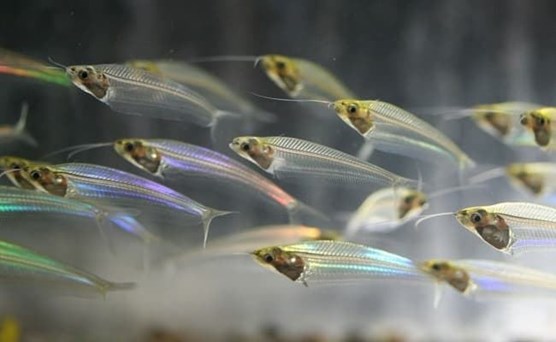
5.- FOOD:
The glass cat is omnivorous.
You can eat fresh or dry food (frozen chironomids or dehydrated daphnia) although you prefer live food, which should be incorporated into your diet on a regular basis.
The food must be of high quality, since they are quite delicate.
When we turn off the lighting, it will be the moment of greatest activity for the glass catfish.
It is time to search for food through the use of their barbels.
It is an omnivorous species that adapts well to frozen and freeze-dried foods, mainly mosquito larvae and brine shrimp.
It may even accept flake food.
The movement of water in the aquarium plays a fundamental role in their feeding.
This must allow the food to remain for a time in the water column so that it can be reached by the fish.
This transparent fish is not as voracious as other catfish species but will prey on guppy or platty fry.
Thanks to its transparent body it is easy to see if it is well fed because it will be easy to detect if its stomach is more swollen after eating.
This Glass Catfish is omnivorous in nature that dwells in deep waters.
Being a selective eater, the glass catfish lives in its natural habitat and accepts a wide range of foods such as pellets, vegetables, flakes, blood shrimp, brine shrimp, moina and grinder worm.
You can feed them once or twice a day.
6.- CARE:
It is a very sensitive fish.
He must live in company since loneliness affects him a lot, and can even lead to his death.
You also have to be careful with the temperature and avoid sudden changes.
Finally, it is necessary to monitor and keep the aquarium clean and in perfect condition, since it is prone to certain diseases such as white spot and mycosis.
The life expectancy of the glass catfish in optimal conditions can vary from 5 to 7 years.
7.- DISEASES:
The biggest challenges faced in keeping these fish are changes in weather conditions.
Since strict water parameters have to be maintained, keeping them in good health is a difficult job.
To minimize health risks to these fish, make sure the place where the fish are raised is kept clean and properly recycled.
Although they may be infected with certain diseases, you must take care that they are not affected by general diseases. In general, the types of diseases that can affect them are:
- Ich: Here, you'll find a white, grainy substance on the surface of their skin, and they'll always be gasping for water.
- Dropsia: Below this, the scales swell and protrude.
- Fungus: There will be a white or gray growth on the surface of your skin.
- Lice: Normally, in this condition, the fish are restless and will always try to rub themselves on the surface, thus trying to eliminate the lice.
When you notice that any of your fish is affected by the type of diseases mentioned above, separate them immediately.
Stop overfeeding them and make changes at regular intervals.
It is to camouflage itself among the vegetation and avoid its natural predators. The skeleton and certain internal organs can be clearly seen through the scales.
They belong to the catfish family, and in captivity they can reach 10 cm or even more.
It is a gregarious fish, that is, it tends to join with other individuals of its species and advances in groups. They are peaceful in behavior, and need a large planted tank with plenty of nooks and crannies.
Although they have a long life expectancy (up to 7 years), they are very sensitive fish, which will react to any change in the parameters and conditions of the aquarium. They should never be kept alone.
It is an extremely curious fish in appearance and behavior: a school of glass catfish will have a striking effect in our planted aquarium.

